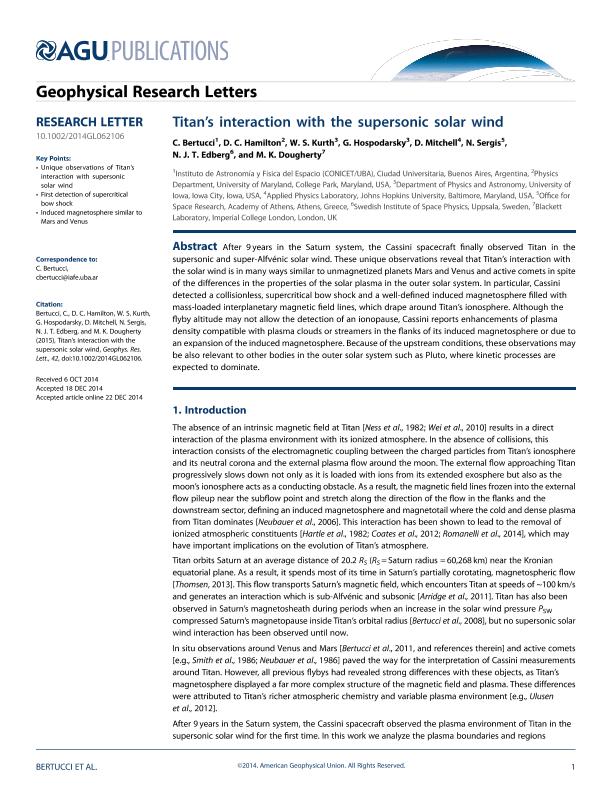Artículo
Titan's interaction with the supersonic solar wind
Bertucci, Cesar ; Hamilton, D. C.; Kurth, W. S.; Hospodarsky, G.; Mitchell, D.; Sergis, N.; Edberg, N. J. T.; Dougherty, M. K.
; Hamilton, D. C.; Kurth, W. S.; Hospodarsky, G.; Mitchell, D.; Sergis, N.; Edberg, N. J. T.; Dougherty, M. K.
 ; Hamilton, D. C.; Kurth, W. S.; Hospodarsky, G.; Mitchell, D.; Sergis, N.; Edberg, N. J. T.; Dougherty, M. K.
; Hamilton, D. C.; Kurth, W. S.; Hospodarsky, G.; Mitchell, D.; Sergis, N.; Edberg, N. J. T.; Dougherty, M. K.
Fecha de publicación:
28/01/2015
Editorial:
American Geophysical Union
Revista:
Geophysical Research Letters
ISSN:
0094-8276
Idioma:
Inglés
Tipo de recurso:
Artículo publicado
Clasificación temática:
Resumen
After 9 years in the Saturn system, the Cassini spacecraft finally observed Titan in the supersonic and super-Alfvénic solar wind. These unique observations reveal that Titan?s interaction with the solar wind is in many ways similar to unmagnetized planets Mars and Venus and active comets in spite of the differences in the properties of the solar plasma in the outer solar system. In particular, Cassini detected a collisionless, supercritical bow shock and a well-defined induced magnetosphere filled with mass-loaded interplanetary magnetic field lines, which drape around Titan?s ionosphere. Although the flyby altitude may not allow the detection of an ionopause, Cassini reports enhancements of plasma density compatible with plasma clouds or streamers in the flanks of its induced magnetosphere or due to an expansion of the induced magnetosphere. Because of the upstream conditions, these observations may be also relevant to other bodies in the outer solar system such as Pluto, where kinetic processes are expected to dominate.
Palabras clave:
Titan
,
Solar Wind
,
Shock
Archivos asociados
Licencia
Identificadores
Colecciones
Articulos(IAFE)
Articulos de INST.DE ASTRONOMIA Y FISICA DEL ESPACIO(I)
Articulos de INST.DE ASTRONOMIA Y FISICA DEL ESPACIO(I)
Citación
Bertucci, Cesar; Hamilton, D. C.; Kurth, W. S.; Hospodarsky, G.; Mitchell, D.; et al.; Titan's interaction with the supersonic solar wind; American Geophysical Union; Geophysical Research Letters; 42; 2; 28-1-2015; 062106, 193-200
Compartir



